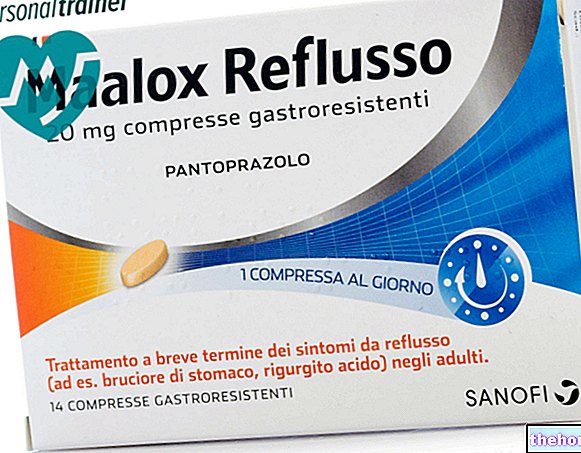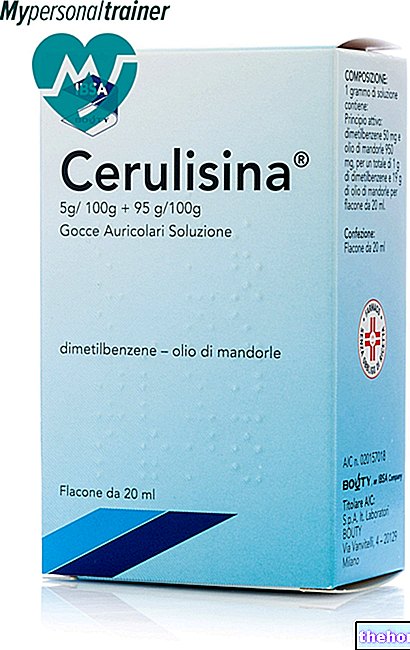Active ingredients: Pantoprazole
PANTOPRAZOLE DOC Generici 20 mg gastro-resistant tablets
Package inserts of Pantoprazole - Generic Drug are available for pack sizes:- PANTOPRAZOLE DOC Generici 20 mg gastro-resistant tablets
- PANTOPRAZOLE DOC Generici 40 mg gastro-resistant tablets
Why is Pantoprazole used - Generic Drug? What is it for?
PANTOPRAZOLE DOC Generici 20 mg is a medicine that reduces the production of acid in the stomach (selective proton pump inhibitor). It is used for the treatment of acid-related diseases of the stomach and intestines.
PANTOPRAZOLE DOC Generici 20 mg is used for the treatment of:
Adults and adolescents aged 12 years and over:
- Treatment of symptoms (e.g. heartburn, acid regurgitation, pain when swallowing) associated with gastroesophageal reflux disease caused by acid reflux from the stomach.
- Long-term treatment of reflux esophagitis (inflammation of the esophagus accompanied by regurgitation of stomach acid) and prevention of its recurrence.
Adults:
- Prevention of duodenal and stomach ulcers caused by non-steroidal anti-inflammatory drugs (NSAIDs, for example, ibuprofen) in patients at risk who require continued NSAID treatment.
Contraindications When Pantoprazole - Generic Drug should not be used
Do not take Pantoprazole 20 mg
- If you are allergic (hypersensitive) to pantoprazole, soya lecithin or any of the other ingredients of Pantup 20 mg (listed in section 6)
- If you are allergic to medicines containing other proton pump inhibitors
Precautions for use What you need to know before taking Pantoprazole - Generic Drug
Talk to your doctor or pharmacist before taking Pantoprazole.
Take special care with PANTOPRAZOLE DOC Generici 20 mg
- If you have severe liver problems. Tell your doctor if you have ever had liver problems. Your doctor will want to check your liver enzymes more frequently, especially if you are taking Pantoprazole 20 mg for long-term therapy. In the event of an increase in liver enzymes, the treatment should be discontinued.
- If you need continued treatment with NSAIDs and are taking PANTOPRAZOLE DOC Generici 20 mg because you have an increased risk of developing gastric and intestinal complications. Each increased risk will be assessed based on its personal risk factors such as age (65 years and over), an experience of gastric or duodenal ulcers or gastric or intestinal bleeding.
- If you have low body stores or risk factors for reduced vitamin B12 and are on long-term treatment with pantoprazole. As with all acid reducing agents, pantoprazole can lead to reduced absorption of vitamin B12.
- If you are taking a medicine containing atazanavir (for the treatment of HIV infection) at the same time as pantoprazole, ask your doctor for specific advice.
- If you take a proton pump inhibitor such as PANTOPRAZOL DOC Generici, especially for longer than one year, you may have a slightly increased risk of fracture of the hip, wrist or spine. If you have osteoporosis or are taking corticosteroids. (which may increase the risk of osteoporosis) consult your doctor.
Tell your doctor immediately if you notice any of the following symptoms:
- an involuntary weight reduction
- recurrent vomiting
- difficulty in swallowing
- presence of blood in the vomit
- looks pale and feels weak (anemia)
- presence of blood in the stool
- severe and / or persistent diarrhea, because Pantoprazole 20 mg has been associated with a modest increase in infectious diarrhea.
Your doctor may decide that you need to have some tests to rule out malignant disease as pantoprazole also relieves the symptoms of cancer and may cause a delay in diagnosis. If your symptoms persist despite treatment, further investigation should be considered.
If you are taking PANTOPRAZOL DOC Generici 20 mg for long-term treatment (more than 1 year) your doctor will probably monitor you on a regular basis. He should report any new or exceptional symptoms and circumstances whenever he meets the doctor.
Interactions Which drugs or foods can modify the effect of Pantoprazole - Generic Drug
PANTOPRAZOLE DOC Generici 20 mg may affect the effectiveness of other medicines, so tell your doctor if you are taking
- Medicines such as ketoconazole, itraconazole and posaconazole (used to treat fungal infections) or erlotinib (used for some types of cancer) as PANTOPRAZOLE DOC Generici 20 mg may stop these and other medicines from working properly.
- Warfarin and phenprocoumon, which affect the thickening or thinning of the blood. You may need further checks.
- Atazanavir (used to treat HIV infection).
Tell your doctor or pharmacist if you are taking, have recently taken or might take any other medicines.
Warnings It is important to know that:
Pregnancy and breastfeeding
There are no adequate data from the use of pantoprazole in pregnant women. Excretion into human breast milk has been reported. If you are pregnant, or think you may be, or are breast-feeding, you should only use this medicine if your doctor considers the benefit to you greater than the potential risk to the fetus or infant.
Ask your doctor or pharmacist for advice before taking any medicine.
Driving and using machines
If you experience side effects such as dizziness or disturbed vision, you should not drive or operate machinery.
Important information about some of the ingredients of PANTOPRAZOLE DOC Generici 20 mg
If you have been told by your doctor that you have an "intolerance to some sugars, contact your doctor before taking this medicine.
PANTOPRAZOLE DOC Generici 20 mg contains soy lecithin. If you are allergic to peanuts or soy, do not use this medicine.
Dose, Method and Time of Administration How to use Pantoprazole - Generic Drug: Posology
Always take this medicine exactly as your doctor has told you. If in doubt, consult your doctor or pharmacist.
When and how should you take PANTOPRAZOLE DOC Generici 20 mg?
Take the tablets 1 hour before a meal without chewing or crushing them and swallow them whole with some water.
Unless advised otherwise by your doctor, the recommended dose is:
Adults and adolescents aged 12 years and over
For the treatment of symptoms associated with gastroesophageal reflux disorders (e.g. heartburn, acid regurgitation, pain when swallowing)
The recommended dose is one tablet a day. This dose usually brings relief within 2 - 4 weeks - at most after another 4 weeks. Your doctor will tell you how long to continue taking the medicine. After that any recurrence of symptoms can be controlled by taking one tablet a day, as needed.
For long-term treatment and to prevent the recurrence of reflux oesophagitis
The recommended dose is one tablet a day. If the symptom returns, your doctor may double the dose, in which case you can use PANTOPRAZOL DOC Generici 40 mg tablets, one a day instead. After healing, the dose can be reduced back to one 20 mg tablet per day.
Adults
For the prevention of duodenal and gastric ulcers in patients requiring continuous NSAID treatment The recommended dose is one tablet per day.
Particular groups of patients:
- If you have severe liver problems, you should not take more than one 20 mg tablet per day.
- Use in children under 12 years. These tablets are not recommended for use in children under 12 years of age.
Overdose What to do if you have taken an overdose of Pantoprazole - Generic Drug
If you take more Pantoprazole 20 mg than you should
Consult your doctor or pharmacist. There are no known symptoms of overdose.
If you forget to take Pantoprazole 20 mg
Do not take a double dose to make up for a forgotten dose. Take your next regular dose at the scheduled time.
If you stop taking PANTOPRAZOLE DOC Generici 20 mg
Do not stop taking these tablets without first checking with your doctor or pharmacist.
If you have any further questions on the use of this medicine, ask your doctor or pharmacist
Side Effects What are the side effects of Pantoprazole - Generic Drug
Like all medicines, this medicine can cause side effects, although not everybody gets them.
The frequency of possible side effects listed below is defined using the following convention
- very common (affects more than 1 in 10 patients)
- common (affects 1 to 10 users in 100)
- uncommon (affects 1 to 10 users in 1,000)
- rare (affects 1 to 10 users in 10,000)
- very rare (affects less than 1 in 10,000 patients)
- not known (frequency cannot be estimated from the available data)
If you experience any of the following side effects, stop taking these tablets and consult your doctor immediately, or contact the nearest hospital emergency department:
- Serious allergic reactions (frequency rare): swelling of the tongue and / or throat, difficulty in swallowing, hives, difficulty in breathing, allergic swelling of the face (Quincke's edema / angioedema), severe dizziness with very fast heart rate and heavy sweating
- Serious skin disorders (frequency not known): skin blistering and rapid deterioration of your general condition, erosion (including slight bleeding) of the eyes, nose, mouth / lips or genitals (Stevens-Johnson syndrome, Lyell's syndrome, Erythema multiforme) and sensitivity to light
- Other serious conditions (frequency not known): yellowing of the skin or whites of the eyes (severe damage to liver cells, jaundice) or fever, rash, and enlarged kidneys sometimes with painful urination or lower back pain (severe inflammation of the kidneys)
Other side effects are:
- Uncommon (affects 1 to 10 users in 1,000) headache; dizziness; diarrhea; feeling of nausea, vomiting; abdominal distension and flatulence (air); constipation; dry mouth; abdominal pain and feeling unwell; rash, rash, rash; itch; feeling of weakness, fatigue or general malaise; sleep disorders
- Rare (affects 1 to 10 users in 10,000) visual disturbances such as blurred vision; urticaria; joint pain; muscle aches; weight changes; increase in body temperature; swelling of the extremities (peripheral edema); allergic reactions; depression, breast enlargement in men
- Very Rare (affects less than 1 in 10,000 patients) disorientation - Not known (frequency cannot be estimated from the available data): Hallucinations, confusion (especially in patients with an "experience of these symptoms); decreased sodium levels in the blood
Side effects identified through blood tests:
- Uncommon (affects 1 to 10 users in 1,000) an increase in liver enzymes
- Rare (affects 1 to 10 users in 10,000) an increase in bilirubin; increased fat in the blood
- Very Rare (affects less than 1 in 10,000 patients) a reduction in the number of platelets, which may cause more bleeding or bruising than normal; a reduction in the number of white blood cells, which can lead to more frequent infections
Not known: If you take PANTOPRAZOL DOC Generici for more than three months, your blood levels of magnesium may drop. Low magnesium levels can manifest themselves with fatigue, involuntary muscle contractions, disorientation, convulsions, dizziness, increased heart rate. If you have any of these symptoms, please consult your doctor immediately. Low levels of magnesium can also lead to a reduction in potassium or calcium levels in the blood. Your doctor should decide whether to check your blood magnesium levels periodically.
Reporting of side effects
If you get any side effects, talk to your doctor or pharmacist. This includes any possible side effects not listed in this leaflet. You can also report side effects directly via the national reporting system listed at https://www.aifa.gov.it/content/segnalazioni-reazioni-avverse
By reporting side effects you can help provide more information on the safety of this medicine.
Expiry and Retention
Keep this medicine out of the sight and reach of children.
Do not use this medicine after the expiry date which is stated on the carton, bottle and blister after "EXP". The expiry date refers to the last day of that month.
For tablets packed in plastic bottles: PANTOPRAZOLE DOC Generici 20 mg can be used for three months after first opening the container.
This medicinal product does not require any special storage conditions.
Do not throw any medicines via wastewater or household waste. Ask your pharmacist how to throw away medicines you no longer use. This will help protect the environment.
What PANTOPRAZOLE DOC Generici 20 mg contains:
The active ingredient is: pantoprazole.
Each gastro-resistant tablet contains 20 mg of pantoprazole (as pantoprazole sodium sesquihydrate).
The other ingredients are:
Core of the tablet
Maltitol (E 965), crospovidone type B, carmellose sodium, anhydrous sodium carbonate (E 500), calcium stearate
Tablet coating
Polyvinyl alcohol, talc (E 553b), titanium dioxide (E 171), macrogol 3350, soy lecithin, yellow iron oxide (E 172), anhydrous sodium carbonate (E 500), methacrylic acid-ethyl acrylate copolymer (1: 1) , triethyl citrate (E 1505)
What Pantoprazole 20 mg looks like and contents of the pack:
PANTOPRAZOL DOC Generici 20 mg gastro-resistant tablets are oval and yellow. PANTOPRAZOLE DOC Generici 20 mg is available in packs of 7, 10, 14, 15, 20, 28, 28 (2X14), 30, 50, 56, 60, 98, 100 tablets for blister packaging and 14, 28, 100 tablets for packaging in HDPE container.
Not all pack sizes may be marketed.
Source Package Leaflet: AIFA (Italian Medicines Agency). Content published in January 2016. The information present may not be up-to-date.
To have access to the most up-to-date version, it is advisable to access the AIFA (Italian Medicines Agency) website. Disclaimer and useful information.
01.0 NAME OF THE MEDICINAL PRODUCT
PANTOPRAZOLE 20 MG GASTROINTESTINAL TABLETS
02.0 QUALITATIVE AND QUANTITATIVE COMPOSITION
Each gastro-resistant tablet contains:
20 mg of pantoprazole (equivalent to 22.6 mg of pantoprazole sodium sesquihydrate)
Excipients: 38,425 mg of maltitol and 0.345 mg of lecithin (derived from soybean oil) (see section 4.4)
For the full list of excipients, see section 6.1.
03.0 PHARMACEUTICAL FORM
Gastro-resistant tablet
Yellow, oval tablet.
04.0 CLINICAL INFORMATION
04.1 Therapeutic indications
Adults and adolescents aged 12 and over
• Gastroesophageal reflux symptoms
• Long-term treatment and prevention of relapse of reflux oesophagitis
Adults
• Prevention of gastroduodenal ulcers induced by non-selective non-steroidal anti-inflammatory drugs (NSAIDs) in patients at risk who require continued NSAID treatment (see section 4.4)
04.2 Posology and method of administration
The tablets should not be chewed or crushed and should be swallowed whole with a little water 1 hour before a meal.
Recommended dose
Adults and adolescents aged 12 and over
Gastroesophageal reflux symptoms
The recommended dose is one PANTOPRAZOL DOC Generici 20 mg tablet per day orally. Relief of symptoms is generally achieved in 2-4 weeks, and a 4-week treatment period is generally required for healing of associated esophagitis. If this is not sufficient, recovery will normally be achieved within an additional 4 weeks of treatment. . Once relief of symptoms is achieved, recurrence of symptoms can be controlled by using reliever treatment of 20 mg pantoprazole once daily if necessary. If adequate control cannot be maintained with reliever treatment, should the transition to ongoing therapy be considered.
Long-term treatment and prevention of relapse of reflux oesophagitis
For long-term treatment, a maintenance dose of one PANTOPRAZOL DOC Generici 20 mg tablet per day is recommended, which can be increased to 40 mg pantoprazole per day in case of relapse. For these cases, PANTOPRAZOLE DOC Generici 40 mg is available. After healing of the relapse, the dose can be reduced again to 20 mg of pantoprazole.
Adults
Prevention of gastric and duodenal ulcers induced by non-selective non-steroidal anti-inflammatory drugs (NSAIDs) in patients at risk who require continued treatment with NSAIDs
The recommended oral dose is one PANTOPRAZOLE DOC Generici 20 mg tablet daily.
Particular groups of patients
Children under 12 years of age
PANTOPRAZOLE DOC Generici is not recommended for use in children below 12 years of age due to limited data on safety and efficacy in this age group.
Hepatic insufficiency
In patients with severely impaired hepatic function, a daily dose of 20 mg of pantoprazole should not be exceeded (see section 4.4).
Kidney failure
No dose adjustment is necessary in patients with impaired renal function.
Senior citizens
No dose adjustment is necessary in elderly patients.
04.3 Contraindications
Hypersensitivity to the active substance, to benzimidazole derivatives, to soybean oil or to any of the other excipients.
04.4 Special warnings and appropriate precautions for use
Hepatic insufficiency
In patients with severe hepatic impairment, hepatic enzymes should be monitored regularly during therapy with pantoprazole, especially in long-term use. In the event of an increase in liver enzymes, treatment should be discontinued (see section 4.2).
Co-administration with NSAIDs
The use of PANTOPRAZOLE DOC Generici 20 mg in the prevention of gastroduodenal ulcers induced by non-selective non-steroidal anti-inflammatory drugs (NSAIDs) should be limited to patients who require continued treatment with NSAIDs and who have an increased risk of gastrointestinal complications. "heightened risk must be carried out based on the presence of individual risk factors, eg. high age (> 65 years), history of gastric or duodenal ulcer or upper gastrointestinal bleeding.
In the presence of alarming symptoms
In the presence of any alarming symptoms (e.g. significant unintentional weight loss, recurrent vomiting, dysphagia, haematemesis, anemia or melaena) and when gastric ulcer is suspected or present, malignancy must be excluded, as the treatment with pantoprazole can relieve symptoms and delay diagnosis.
If symptoms persist despite adequate treatment, further investigation should be considered.
Co-administration with atazanavir
Co-administration of atazanavir with proton pump inhibitors is not recommended (see section 4.5). If the combination of atazanavir with a proton pump inhibitor is judged unavoidable, close clinical monitoring (e.g. viral load) is recommended in combination with an increase in the dose of atazanavir to 400 mg using 100 mg of ritonavir. A pantoprazole dose of 20 mg per day should not be exceeded.
Influence on the absorption of vitamin B12
Pantoprazole, like all medicinal products that inhibit acid secretion, may reduce the absorption of vitamin B12 (cyanocobalamin) as a consequence of hypo- or achlorhydria. This should be considered in long-term therapy or in the case of observed clinical symptoms. in patients with reduced body stores or risk factors for reduced vitamin B12 absorption.
Long-term treatment
In long-term treatment, especially when a 1 year treatment period is exceeded, patients should be kept under regular surveillance.
Gastrointestinal infections caused by bacteria
Pantoprazole, like all pump inhibitors (PPIs), might be expected to increase the counts of bacteria normally present in the upper gastrointestinal tract. Treatment with PANTOPRAZOLE DOC Generici may lead to a modest increase in the risk of gastrointestinal infections caused by bacteria such as Salmonella And Campylobacter.
This medicine contains maltitol.
Patients with rare hereditary problems of fructose intolerance should not take this medicine.
This medicinal product contains lecithin derived from soybean oil. If the patient is allergic to peanut or soy, he should not use this medicinal product (see section 4.3).
04.5 Interactions with other medicinal products and other forms of interaction
Effect of pantoprazole on the absorption of other medicinal products
Due to the marked and long-lasting inhibition of gastric acid secretion, pantoprazole may reduce the absorption of medicinal products whose bioavailability is dependent on gastric pH, eg some azole antifungals such as ketoconazole, itraconazole, posaconazole and other medicines such as erlotinib.
HIV medicines (atazanavir)
Co-administration of atazanavir and other anti-HIV drugs whose absorption is pH-dependent with proton pump inhibitors may lead to a substantial reduction in the bioavailability of these anti-HIV medicinal products and may modify the efficacy of these medicinal products. Therefore , co-administration of proton pump inhibitors with atazanavir is not recommended (see section 4.4).
Coumarin anticoagulants (phenprocoumon or warfarin)
Although no interactions were observed during concomitant treatment with phenprocoumon or warfarin in clinical pharmacokinetic studies, a few isolated cases of International Normalized Ratio (INR) variation during concomitant treatment were observed in the post-marketing period. Thus, in patients treated with coumarin anticoagulants (e.g. phenprocoumon or warfarin), it is recommended to monitor the prothrombin time / INR when starting treatment with pantoprazole, when it is discontinued or when it is administered intermittently.
Other interaction studies
Pantoprazole is extensively metabolised in the liver by the cytochrome P450 enzyme system. The major route of metabolism is demethylation by CYP2C19 and other metabolic pathways include oxidation by CYP3A4.
Interaction studies with substances also metabolised through these enzyme systems, such as carbamazepine, diazepam, glibenclamide, nifedipine, and an oral contraceptive containing levonorgestrel and ethinyl estradiol did not reveal clinically significant interactions.
The results of a series of interaction studies demonstrate that pantoprazole does not affect the metabolism of active substances metabolised by CYP1A2 (such as caffeine, theophylline), CYP2C9 (such as piroxicam, diclofenac, naproxen), CYP2D6 (such as metoprolol), CYP2E1 (such as ethanol) and does not interfere with p-glycoprotein mediated absorption of digoxin.
There was no evidence of interactions with concomitantly administered antacids.
Interaction studies have also been conducted by administering pantoprazole concomitantly with the respective antibiotics (clarithromycin, metronidazole, amoxicillin). No clinically significant interactions were noted.
04.6 Pregnancy and lactation
Pregnancy
There are no adequate data from the use of pantoprazole in pregnant women. Studies in animals have shown reproductive toxicity (see section 5.3). The potential risk for humans is unknown. PANTOPRAZOLE DOC Generici should not be used. during pregnancy, unless absolutely necessary.
Feeding time
Animal studies have shown excretion of pantoprazole into breast milk. Excretion into human breast milk has been reported. Therefore a decision whether to continue / discontinue breastfeeding or to continue / discontinue PANTOPRAZOL DOC Generici therapy should be made taking into account the benefit of breastfeeding for the infant and the benefit of Pantoprazole therapy for the mothers.
04.7 Effects on ability to drive and use machines
Adverse drug reactions such as dizziness and visual disturbances may occur (see section 4.8). In such cases, patients should not drive or operate machinery.
04.8 Undesirable effects
Approximately 5% of patients can be expected to experience adverse drug reactions (ADRs).The most commonly reported ADRs are diarrhea and headache, both of which occur in approximately 1% of patients.
The table below lists the adverse reactions reported with pantoprazole, arranged according to the following frequency classification:
very common (≥1 / 10); common (≥1 / 100,
For all adverse reactions from post-marketing experience, it is not possible to establish any frequency of Adverse Reaction and therefore they are indicated with a frequency of "not known".
Within each frequency class, adverse reactions are reported in order of decreasing severity.
Table 1. Adverse reactions with pantoprazole in clinical studies and post-marketing experience
04.9 Overdose
There are no known symptoms of overdose in humans.
Systemic exposure up to 240 mg administered intravenously over 2 minutes was well tolerated.
Since pantoprazole is extensively protein bound, it is not readily dialyzable.
In case of overdose with clinical signs of intoxication, no specific therapeutic recommendations can be made, except for symptomatic and supportive treatment.
05.0 PHARMACOLOGICAL PROPERTIES
05.1 Pharmacodynamic properties
Pharmacotherapeutic category: proton pump inhibitors.
ATC code: A02BC02.
Mechanism of action
Pantoprazole is a substituted benzimidazole derivative that inhibits acid secretion in the stomach via a specific blockade of the proton pumps of the parietal cells.
Pantoprazole is converted to its active form in the acid canaliculi of the parietal cells where it inhibits the enzyme H +, K + -ATPase, which is the final stage in the production of hydrochloric acid in the stomach. Inhibition is dose-dependent and affects both basal and stimulated acid secretion. In most patients, symptoms resolve within 2 weeks. As with other proton pump inhibitors and H2 receptor inhibitors, treatment with pantoprazole causes a reduction in stomach acidity and consequently an increase in gastrin proportional to the reduction in acidity. The increase in gastrin is reversible. Since pantoprazole binds to the enzyme distal to the cellular receptor, it can act on the secretion of hydrochloric acid regardless of the stimulation of other substances (acetylcholine, histamine, gastrin). The effect is the same whether the product is administered for orally and intravenously.
Fasting gastrin values increase with pantoprazole. In short-term use, they do not exceed the upper limit in most cases. During long-term treatment, gastrin levels double in most cases. An excessive increase, however, only occurs in isolated cases. Consequently, in a minority of cases during long-term treatment, a mild to moderate increase in the number of specific endocrine cells (ECL, enterochromaffin-like cells) is observed in the stomach (simple to adenomatoid hyperplasia). However, in agreement with the studies conducted so far (see section 5.3), the formation of carcinoid precursors (atypical hyperplasia) or gastric carcinoids, as found in animal experiments, can be excluded in humans.
According to the results of the animal studies, an influence of longer-term treatment with pantoprazole on endocrine parameters of more than one year cannot be completely excluded.
05.2 "Pharmacokinetic properties
Absorption
Pantoprazole is rapidly absorbed and maximal plasma concentrations are achieved already after a single oral dose of 40 mg. Maximum serum concentrations around 2 - 3 mcg / ml are reached on average about 2.5 hours after administration, and these values remain constant after repeated administration.
Pharmacokinetic characteristics do not change after single or repeated administration.
In the dose range of 10 to 80 mg, the plasma kinetics of pantoprazole are linear after both oral and intravenous administration.
The absolute bioavailability of the tablet is approximately 77%. Concomitant food intake does not affect AUC, maximum serum concentration and therefore bioavailability. Only the variability of the lag-time will be increased by the simultaneous food intake.
Distribution
Serum protein binding of pantoprazole is approximately 98%. The volume of distribution is approximately 0.15 l / kg.
Elimination
The substance is almost exclusively metabolised in the liver. The major metabolic pathway is demethylation by CYP2C19 with subsequent conjugation with sulfate, the other metabolic pathway includes oxidation by CYP3A4. The terminal phase half-life is about 1 hour and clearance is around 0.1 l / h / kg. Some cases of slow drug elimination have been observed.
Due to the specific binding of pantoprazole to the proton pumps of the parietal cells the elimination half-life does not correlate with the longer duration of action (inhibition of acid secretion).
Renal elimination represents the major route of excretion (approximately 80%) for the metabolites of pantoprazole, the remainder is excreted in the faeces. The major metabolite in both serum and urine is desmethylpantoprazole which is conjugated with sulphate. of the main metabolite (approximately 1.5 h) is not much more prolonged than that of pantoprazole.
Particular groups of patients
Approximately 3% of the European population have a lack of CYP2C19 enzyme function and are called poor metabolisers. In these individuals the metabolism of pantoprazole is likely to be catalysed primarily by CYP3A4. After a single administration of pantoprazole 40 mg, the area mean under the plasma concentration-time curve was approximately 6-fold higher in poor metabolisers than in subjects who have a functional CYP2C19 enzyme (extensive metabolisers). The mean peak plasma concentrations had increased by approximately 60%. These findings have no implications for the posology of pantoprazole.
Dosage reduction is not recommended when pantoprazole is administered to patients with impaired renal function (including dialysis patients). The half-life of pantoprazole is short, as observed in healthy subjects. Only very small amounts of pantoprazole are dialyzed.
Although the half-life of the major metabolite is moderately prolonged (2-3 h), excretion is nevertheless rapid and therefore no accumulation occurs.
Although in patients with liver cirrhosis (Child class A and B) the half-life values increase up to 3-6 hours and the AUC values increase by a factor of 3-5, the maximum serum concentration is only modestly increased by a factor of 1.3 compared to that of healthy subjects.
A slight increase in AUC and Cmax values observed in elderly volunteers compared to the younger group is also not clinically relevant.
Children
After administration of single oral doses of 20 or 40 mg of pantoprazole to children aged 5 to 16 years, AUC and Cmax were within the range of corresponding values in adults.
After administration of single i.v. doses of 0.8 or 1.6 mg / kg of pantoprazole to children aged 2-16 years, there was no significant association between pantoprazole clearance and age or weight.
AUC and volume of distribution were in agreement with the adult data.
05.3 Preclinical safety data
Non-clinical data reveal no special hazard for humans based on conventional studies of safety pharmacology, repeated dose toxicity and genotoxicity.
Neuroendocrine tumors were found in two-year carcinogenicity studies in rats. In addition, squamous cell papillomas were found in the anterior part of the stomach of rats. The mechanism by which benzimidazole derivatives induce the formation of gastric carcinoids has been carefully studied and allows us to conclude that this is a secondary reaction to the marked increase in gastrin which occurs in the rat during chronic treatment with high doses.
In the two-year rodent studies, an increase in the number of liver tumors was observed in rats and female mice and was attributed to the high metabolism of pantoprazole in the liver.
A slight increase in neoplastic changes of the thyroid was observed in the group of rats treated with the highest dose (200 mg / kg). The onset of these neoplasms is associated with pantoprazole-induced changes in the catabolism of thyroxine in the rat liver. Since the therapeutic dose in humans is low, no harmful effects on the thyroid glands are to be expected.
In animal reproduction studies, signs of mild foetotoxicity were observed at doses above 5 mg / kg. Studies have shown no impairment of fertility or teratogenic effects.
Transplacental passage has been studied in the rat and increases as gestation progresses. As a result, the concentration of pantoprazole in the fetus increases just before birth.
06.0 PHARMACEUTICAL INFORMATION
06.1 Excipients
Tablet core:
maltitol (E 965);
crospovidone type B;
carmellose sodium;
anhydrous sodium carbonate (E 500);
calcium stearate.
Tablet coating:
polyvinyl alcohol;
talc (E 553b);
titanium dioxide (E 171);
macrogol 3350;
soy lecithin (E 322);
yellow iron oxide (E 172);
anhydrous sodium carbonate (E 500);
methacrylic acid-ethyl acrylate copolymer (1: 1);
triethyl citrate (E 1505).
06.2 Incompatibility
Not relevant.
06.3 Period of validity
For Alu / Alu blisters: 3 years.
For HDPE bottles: 3 years.
After first opening the bottle, use the medicine within 3 months.
06.4 Special precautions for storage
This medicinal product does not require any special storage conditions.
06.5 Nature of the immediate packaging and contents of the package
Alu / Alu blisters.
HDPE container with PP closure and desiccant.
Packaging:
7, 10, 14, 15, 20, 28, 28 (2X14), 30, 50, 56, 60, 98, 100 gastro-resistant tablets (blister packaging).
14, 28, 100 gastro-resistant tablets (HDPE container).
Not all pack sizes may be marketed.
06.6 Instructions for use and handling
No special instructions.
Unused medicine and waste derived from this medicine must be disposed of in accordance with local regulations.
07.0 MARKETING AUTHORIZATION HOLDER
DOC Generici S.r.l. - Via Manuzio 7 - 20124 Milan
08.0 MARKETING AUTHORIZATION NUMBER
PANTOPRAZOLE DOC Generici 20 mg gastro-resistant tablets - 7 tablets in Al / Al blister - AIC 038437012 / M
PANTOPRAZOLE DOC Generici 20 mg gastro-resistant tablets - 10 tablets in Al / Al blister - AIC 038437024 / M
PANTOPRAZOLE DOC Generici 20 mg gastro-resistant tablets - 14 tablets in Al / Al blister - AIC 038437036 / M
PANTOPRAZOLE DOC Generici 20 mg gastro-resistant tablets - 15 tablets in Al / Al blister - AIC 038437048 / M
PANTOPRAZOLE DOC Generici 20 mg gastro-resistant tablets - 20 tablets in Al / Al blister - AIC 038437051 / M
PANTOPRAZOLE DOC Generici 20 mg gastro-resistant tablets - 28 tablets in Al / Al blister - AIC 038437063 / M
PANTOPRAZOLE DOC Generici 20 mg gastro-resistant tablets - 28 (2x14) tablets in Al / Al blister - AIC 038437075 / M
PANTOPRAZOLE DOC Generici 20 mg gastro-resistant tablets - 30 tablets in Al / Al blister - AIC 038437087 / M
PANTOPRAZOLE DOC Generici 20 mg gastro-resistant tablets - 50 tablets in Al / Al blister - AIC 038437099 / M
PANTOPRAZOLE DOC Generici 20 mg gastro-resistant tablets - 56 tablets in Al / Al blister - AIC 038437101 / M
PANTOPRAZOLE DOC Generici 20 mg gastro-resistant tablets - 60 tablets in Al / Al blister - AIC 038437113 / M
PANTOPRAZOLE DOC Generici 20 mg gastro-resistant tablets - 98 tablets in Al / Al blister - AIC 038437125 / M
PANTOPRAZOLE DOC Generici 20 mg gastro-resistant tablets - 100 tablets in Al / Al blister - AIC 038437137 / M
PANTOPRAZOLE DOC Generici 20 mg gastro-resistant tablets - 14 tablets in HDPE bottle - AIC 038437149 / M
PANTOPRAZOLE DOC Generici 20 mg gastro-resistant tablets - 28 tablets in HDPE bottle - AIC 038437152 / M
PANTOPRAZOLE DOC Generici 20 mg gastro-resistant tablets - 100 tablets in HDPE bottle - AIC 038437164 / M
09.0 DATE OF FIRST AUTHORIZATION OR RENEWAL OF THE AUTHORIZATION
July 2009
10.0 DATE OF REVISION OF THE TEXT
November 2011




























